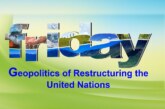Dr. Arvind Kumar*
Wildfires are wreaking havoc on the environment, wildlife, human health, and infrastructure from Australia to Canada, the United States to China, across Europe, and the Amazon. Wildfires are fast becoming a recurring phenomenon often occurring with more intensity, and extreme fires are projected to increase by 50% between now and 2100.
Wildfires, another curse of climate change, are growing in intensity and spreading in rage across Earth’s ecosystems. Wildfires are wreaking havoc on the environment, wildlife, human health, and infrastructure from Australia to Canada, the United States to China, across Europe, and the Amazon. A recently-released report entitled Spreading like Wildfires: The Rising Threat of Extraordinary landscape Fires, by UNEP & GRID-Arendal, calls on governments to adopt a “fire-ready formula” to minimize risks and support recovery from wildfires.
Wildfires are fast becoming a recurring phenomenon often occurring with more intensity, and extreme fires are projected to increase by 50% between now and 2100. According to the UNEP report, both climate change and land-use change are contributing to this trend, which is projected to get increased globally, even in areas previously unaffected, such as the Arctic. Adding that wildfires and climate change are circular in their causes, the Report further notes that as fires contribute significant greenhouse gases to the atmosphere and thus aggravate climate change; climate change also gets worsened as peatlands and rainforests become “tinderboxes” rather than helping to slow temperature rise.

Other impacts of wildfires include, such as respiratory and cardiovascular impacts on human health caused by inhaling wildfire smoke; economic costs to rebuild, which can often be beyond the means of low-income countries, the degrading of watersheds by wildfires’ pollutants; and contaminated wastes left behind. This report is designed to take stock of the scale and extent of the global wildfire crisis.
Stating that not all fires are harmful, and not all fires need to be extinguished as they serve significant ecological purposes; nevertheless, some scientists note that wildfires that burn for weeks, and that may affect millions of people over thousands of square kilometres present challenges for which the world, right now, is not prepared. Conceding that lightning strikes and human carelessness have always – and will always – spark uncontrolled blazes, the UNEP Report informs that anthropogenic climate change, land-use change, and poor land and forest management mean wildfires are more often encountering the fuel and weather conditions conducive to entail destructive potential.

Admittedly, wildfires are burning longer and hotter in places they have always occurred previously; nonetheless, wildfires are also flaring up in unexpected places too, especially in drying peatlands and on thawing permafrost. The costs in human lives and livelihoods can be judged by the number of humans who perish in the flames or contract respiratory diseases from the toxic smoke, or by the number of towns, homes, businesses, and communities affected by the fire. A recent study conducted across 43 countries was published in The Lancet, and it indicates that annual exposure to wildfire smoke results in more than 30, 000 deaths across the 43 countries. A heavy price is also paid by other species, apart from a devastating loss of habitats, the smouldering swathes of land left behind in a wildfire’s wake are scattered with the charred remains of animals and plants possibly fast-tracking extinctions.
The outbreak of wildfires in the Pantanal, the world’s largest tropical wetland, went out of control, and the resultant impact was the destruction of almost a third of one of the world’s greatest biodiversity hotspots, and the scientists are sceptical about its full recovery. Apart from causing a diminution in biodiversity, wildfires also contribute to a climate change feedback loop by emitting massive quantities of greenhouse gases into the atmosphere, triggering more warming, more drying, and more burning. IPCC reports have already sounded warning signals that the heating of the Planet Earth is turning landscapes into tinderboxes, and more extreme weather means stronger, hotter, and drier winds to aggravate flames of wildfires.

Asserting that international response to wildfires has thus far been tardy, with many countries suffering from a chronic lack of investment in planning and prevention, the recent UNEP Report explicitly makes it abundantly clear that the true cost of wildfires – financial, social, and environmental – extends for days, weeks, and even years after the flames subside. In order to facilitate better preparation and harness adequate measures to limit the widespread damage caused by wildfires, there is a need to heed the clear warnings and recommendations outlined in the UNEP Report.
While emphasizing the need for working with nature, communities, harnessing local knowledge, and investing money and political capital in reducing the likelihood of wildfires starting in the first place and the risk of damage and loss that comes when they do, the UNEP Report also recommends following crucial next steps for policymakers:
- Audit your full wildfire costs and invest in planning, prevention, and recovery, not just response: One assessment estimated the annualized economic burden from wildfire for the United States to be between $71.1 billion to $347.8 billion ($2016 US). Most nations do not have any assessment. Commonly, more than half the expenditures related to wildfires are for a response, while planning typically receives just 0.2 percent of the total budget for wildfires.
- Learn from others, best practice is out there: Governments and communities need to proactively learn from each other’s experiences, seeking out best practices and inspiring examples from around the world with the sharing of data, information, and analysis to improve forecasting and learning. Specific efforts to include both indigenous leaders and women in disaster risk management are crucial as research has shown that their input on risk reduction is fundamental towards effective solutions. No single country has yet formulated the perfect response, but many are making progress in different aspects of managing the risks of wildfires. Together we can learn from each other.
- A stronger multilateral response is needed: The UN system lacks robust wildfire expertise dedicated to this challenge as the management of wildfires is seen as mainly a national responsibility. This must change. Wildfires need to be placed in the same category of global humanitarian response as major earthquakes and floods.
*President, India Water Foundation



